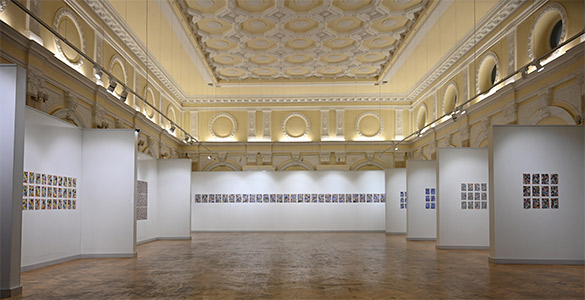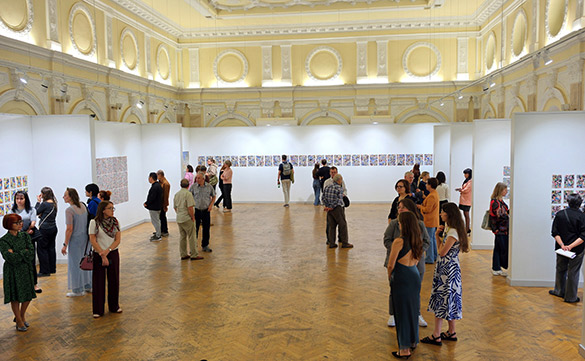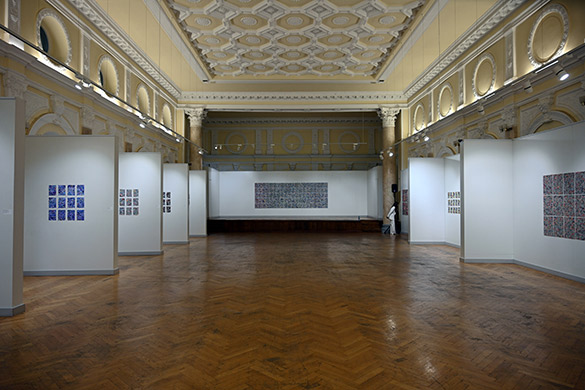
OtGO Solo Show ‚Cabinet of Curiosities‘ 24th September - 19th October 2025
NATIONAL ART MUSEUM OF MOLDOVA, Chișinău, Moldova
The opening is on September 24th at 4 p.m. Everyone is cordially invited!
Ministerul Culturii al Republicii Moldova
Muzeul Național de Artă al Moldovei
str. 31 August 1989, nr. 115 www.mnam.md
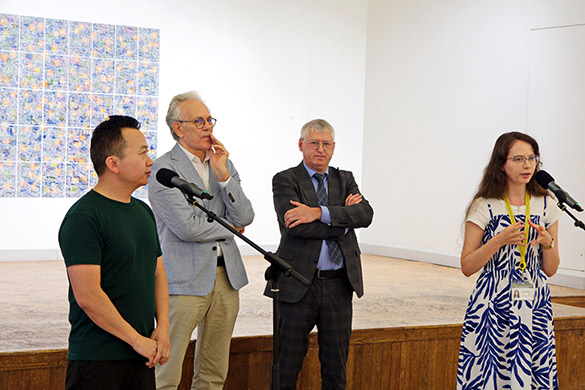 Vladimir Vornic, State Secretary in the Ministry of Culture of the Republic of Moldova,
Vladimir Vornic, State Secretary in the Ministry of Culture of the Republic of Moldova,
Tudor Zbârnea, Director General of the Museum, Ana Eremia and OtGO
NATIONAL ART MUSEUM OF MOLDOVA OtGO Solo Show ‚Cabinet of Curiosities‘
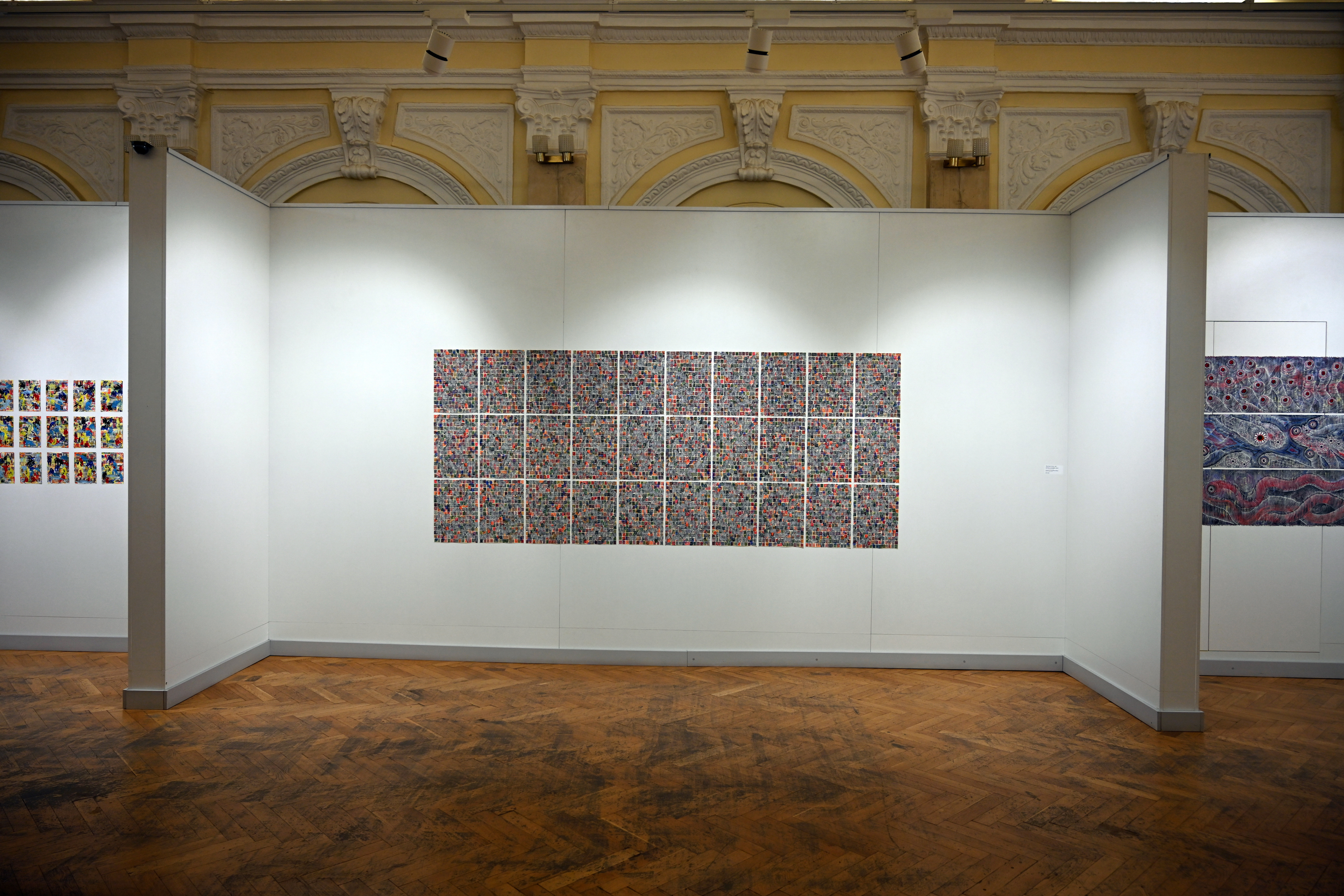
NATIONAL ART MUSEUM OF MOLDOVA OtGO Solo Show ‚Cabinet of Curiosities‘
Diana Cernolev: Expoziția personală Cabinet of Curiosities semnată de OtGO (Moldovan and English)
Octombrie, 2025 – Chișinău, Moldova
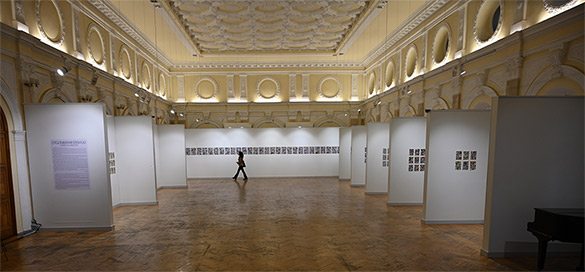
NATIONAL ART MUSEUM OF MOLDOVA OtGO Solo Show ‚Cabinet of Curiosities‘
«Wunderkammer Göschenen» Reise
Urner Wochenblatt | 149. Jahrgang | Samstag, 28. September 2025
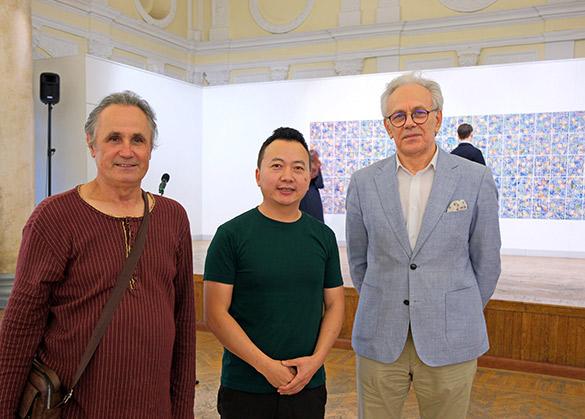
Prof. Simion Zamsa, OtGO and Tudor Zbârnea
NATIONAL ART MUSEUM OF MOLDOVA OtGO Solo Show ‚Cabinet of Curiosities‘
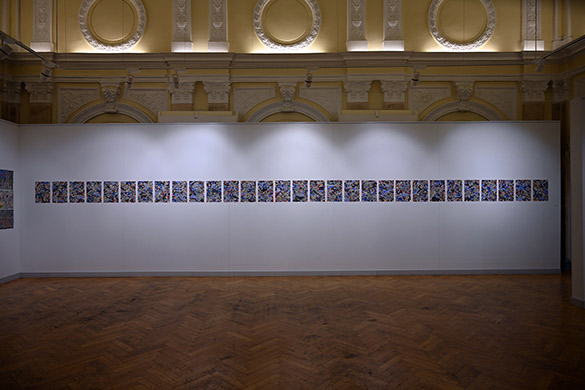
NATIONAL ART MUSEUM OF MOLDOVA OtGO Solo Show ‚Cabinet of Curiosities‘
Past exhibition:
CABINET of CURIOSITIES
VALLETTA CONTEMPORARY
16th May 2025 – 14th August 2025
A solo exhibition by OtGO
NATIONAL ART MUSEUM OF MOLDOVA, Chișinău, Moldova
The opening is on September 24th at 4 p.m. Everyone is cordially invited!
Ministerul Culturii al Republicii Moldova
Muzeul Național de Artă al Moldovei
str. 31 August 1989, nr. 115 www.mnam.md
Expoziția personală a artistului mongol Otgonbayar Ershuu (OtGO) – „CABINET of CURIOSITIES”
Miercuri, 24 septembrie 2025, ora 16:00, Muzeul Național de Artă al Moldovei vă invită la inaugurarea expoziției artistului Otgonbayar Ershuu cu genericul „CABINET of CURIOSITIES”.
Vă așteptăm să descoperiți un univers vizual unic, plin de mister și surprize!
Inspiră... expiră... inspiră... expiră – trasează o linie. Repetă.
Aceasta este practica artistică meditativă a lui Otgonbayar Ershuu, cunoscut sub numele scurt de OtGO. El este unul dintre cei mai remarcabili artiști din Mongolia și trăiește la Berlin de aproximativ douăzeci de ani. Acest fapt i-a lărgit experiențele culturale și a avut un impact și asupra bazei materiale a creației sale artistice. Cu toate acestea, nucleul său spiritual rămâne ferm înrădăcinat în patrimoniul cultural al Mongoliei.
Trasând linie după linie, lucrările lui OtGO devin texturi complexe de urme picturale, împletite cu straturi de înțelesuri. Arta sa este meditativă și iterativă în multe privințe. Fiind un pictor de Thangka, el provine dintr-o lungă tradiție de creare a imaginilor religioase în budismul lamaist, o tradiție în care pictura și meditația nu au fost niciodată activități separate. În această tradiție, fiecare linie, fiecare pată de culoare este atât premeditată, cât și o meditație în sine.
O astfel de tradiție este cea de la care a plecat OtGO. Iar plecarea aici nu înseamnă doar relocarea lui OtGO la Berlin, ci și faptul că el reinterpretează în mod radical arta imaginii din interiorul patrimoniului său mongol, nu prin a-i abandona dimensiunea spirituală, ci prin a-i schimba contextul artistic și social. Practica de a desena linie după linie într-o stare meditativă rămâne activă în procesul său, dar subiectul încorporează acum noile sale contexte sociale și politice și atitudinile sale foarte personale față de acestea.
De exemplu, lucrarea sa masivă „Cabinet of Curiosities”, care la rândul său este împărțită în patru părți, vizează chestiuni legate de viață (Fetus) și moarte (Memento Mori) și multe altele, inclusiv Caii, care pentru orice mongol reprezintă un subiect important, deoarece „mongolii cred că scopul vieții este de a trăi ‘tegsh’, în echilibru cu lumea. O persoană stă singură și puternică în centrul lumii, cu infinitul albastru al Tatălui-Cer (Tenger) deasupra și cu Pământul-Mamă (Gazar Eje) care o susține și o hrănește dedesubt. Trăind o viață onestă și respectuoasă, o ființă umană (hun) își va menține lumea în echilibru și își va maximiza puterea personală (calul-vânt, hiimori).” Un cal în cultura mongolă este, așadar, mult mai mult decât o marfă sau o chestiune de mândrie; un cal este o manifestare a sufletului omului, a destinului și a viitorului său.
„Cabinet of Curiosities” este compus din sute de foi (în mare parte) de dimensiunea A5, care formează blocuri mari ce servesc drept recipiente vizuale pentru subiectele abordate de OtGO. Primul strat al acestor hârtii este format din colaje de timbre poștale istorice folosite, din Germania, Europa, Mongolia și de mai departe. Aceste colaje servesc drept fundal pentru picturile lui OtGO. Este important de menționat aici că Genghis-han și succesorii săi au creat cel mai eficient sistem poștal pe care lumea l-a văzut vreodată la începutul secolului al XIII-lea, făcând posibilă transmiterea informațiilor de la Marea Chinei până la granițele Europei în 7-10 zile cu ajutorul mesagerilor călare. Evident, alegerea lui OtGO aici nu este una arbitrară, ci o aluzie subtilă la realizările patrimoniului mongol.
Lucrările lui OtGO transmit noțiunea de artă din și în Mongolia. OtGO nu este doar o parte din ea – el este o forță motrice în această dinamică.
Otgonbayar Ershuu s-a născut în 1981 la Ulaanbaatar, Mongolia. Talentul său a fost descoperit devreme, iar la vârsta de 15 ani a organizat primele expoziții personale. A studiat pictura tradițională mongolă la Ulaanbaatar (1996–1998).
După absolvire, a participat în calitate de pictor și restaurator la câteva vizite de studiu la situri istorice din Mongolia. A studiat diverse tehnici în temple budist-lamaiste, iconografia picturii în miniatură, precum și baza spirituală a acestora.
Între 2007 și 2010 a studiat la Universitatea de Artă din Berlin, pe care a absolvit-o cu titlul de Master of Arts. După studii, OtGO a deschis primul Centru Cultural Mongol din Berlin (2010–2013) și a fondat Galeria ZURAG Berlin (2010–2014) – prima galerie fondată și condusă de un mongol în afara Mongoliei.
În 2015, OtGO a fost distins cu Premiul Mare la Bienala Internațională de Pictură de la Chișinău, Republica Moldova. În 2019, a participat la proiectul Curating al Universității de Artă din Berlin și a obținut certificatul universitar. Între 2018 și 2025, a activat în calitate de curator-șef și responsabil de relații externe la Galeria Națională de Artă a Mongoliei, în paralel cu activitatea sa artistică.
OtGO și-a expus lucrările în Japonia, Suedia, Franța, Țările de Jos, India, Republica Cehă, Elveția, Moldova, Polonia, România, Rusia, Emiratele Arabe Unite, Singapore, Georgia, Germania și Mongolia.
Lucrările sale se regăsesc în diverse muzee, instituții și colecții private, printre care: Galeria Națională de Artă a Mongoliei, Muzeul Ulaanbaatar, Mongolia; Muzeul Național de Artă al Moldovei, Chișinău, Republica Moldova; Muzeul de Artă al Mongoliei din Ulaanbaatar, Mongolia; HSBC (Hongkong & Shanghai Banking Corporation); Castelul Seeheim, Constance, Germania; Vechiul Castel Baruth, Germania; Fondation Kunstdepot, Göschenen, Elveția; Ambasada Mongoliei în Germania; MRK Gruppe, Dresda – München, Germania.
Artistul trăiește între Berlin și Ulaanbaatar.
Miercuri, 24 septembrie 2025, ora 16:00, Muzeul Național de Artă al Moldovei vă invită la inaugurarea expoziției artistului Otgonbayar Ershuu cu genericul „CABINET of CURIOSITIES”.
Vă așteptăm să descoperiți un univers vizual unic, plin de mister și surprize!
Inspiră... expiră... inspiră... expiră – trasează o linie. Repetă.
Aceasta este practica artistică meditativă a lui Otgonbayar Ershuu, cunoscut sub numele scurt de OtGO. El este unul dintre cei mai remarcabili artiști din Mongolia și trăiește la Berlin de aproximativ douăzeci de ani. Acest fapt i-a lărgit experiențele culturale și a avut un impact și asupra bazei materiale a creației sale artistice. Cu toate acestea, nucleul său spiritual rămâne ferm înrădăcinat în patrimoniul cultural al Mongoliei.
Trasând linie după linie, lucrările lui OtGO devin texturi complexe de urme picturale, împletite cu straturi de înțelesuri. Arta sa este meditativă și iterativă în multe privințe. Fiind un pictor de Thangka, el provine dintr-o lungă tradiție de creare a imaginilor religioase în budismul lamaist, o tradiție în care pictura și meditația nu au fost niciodată activități separate. În această tradiție, fiecare linie, fiecare pată de culoare este atât premeditată, cât și o meditație în sine.
O astfel de tradiție este cea de la care a plecat OtGO. Iar plecarea aici nu înseamnă doar relocarea lui OtGO la Berlin, ci și faptul că el reinterpretează în mod radical arta imaginii din interiorul patrimoniului său mongol, nu prin a-i abandona dimensiunea spirituală, ci prin a-i schimba contextul artistic și social. Practica de a desena linie după linie într-o stare meditativă rămâne activă în procesul său, dar subiectul încorporează acum noile sale contexte sociale și politice și atitudinile sale foarte personale față de acestea.
De exemplu, lucrarea sa masivă „Cabinet of Curiosities”, care la rândul său este împărțită în patru părți, vizează chestiuni legate de viață (Fetus) și moarte (Memento Mori) și multe altele, inclusiv Caii, care pentru orice mongol reprezintă un subiect important, deoarece „mongolii cred că scopul vieții este de a trăi ‘tegsh’, în echilibru cu lumea. O persoană stă singură și puternică în centrul lumii, cu infinitul albastru al Tatălui-Cer (Tenger) deasupra și cu Pământul-Mamă (Gazar Eje) care o susține și o hrănește dedesubt. Trăind o viață onestă și respectuoasă, o ființă umană (hun) își va menține lumea în echilibru și își va maximiza puterea personală (calul-vânt, hiimori).” Un cal în cultura mongolă este, așadar, mult mai mult decât o marfă sau o chestiune de mândrie; un cal este o manifestare a sufletului omului, a destinului și a viitorului său.
„Cabinet of Curiosities” este compus din sute de foi (în mare parte) de dimensiunea A5, care formează blocuri mari ce servesc drept recipiente vizuale pentru subiectele abordate de OtGO. Primul strat al acestor hârtii este format din colaje de timbre poștale istorice folosite, din Germania, Europa, Mongolia și de mai departe. Aceste colaje servesc drept fundal pentru picturile lui OtGO. Este important de menționat aici că Genghis-han și succesorii săi au creat cel mai eficient sistem poștal pe care lumea l-a văzut vreodată la începutul secolului al XIII-lea, făcând posibilă transmiterea informațiilor de la Marea Chinei până la granițele Europei în 7-10 zile cu ajutorul mesagerilor călare. Evident, alegerea lui OtGO aici nu este una arbitrară, ci o aluzie subtilă la realizările patrimoniului mongol.
Lucrările lui OtGO transmit noțiunea de artă din și în Mongolia. OtGO nu este doar o parte din ea – el este o forță motrice în această dinamică.
Thomas Eller
Otgonbayar Ershuu s-a născut în 1981 la Ulaanbaatar, Mongolia. Talentul său a fost descoperit devreme, iar la vârsta de 15 ani a organizat primele expoziții personale. A studiat pictura tradițională mongolă la Ulaanbaatar (1996–1998).
După absolvire, a participat în calitate de pictor și restaurator la câteva vizite de studiu la situri istorice din Mongolia. A studiat diverse tehnici în temple budist-lamaiste, iconografia picturii în miniatură, precum și baza spirituală a acestora.
Între 2007 și 2010 a studiat la Universitatea de Artă din Berlin, pe care a absolvit-o cu titlul de Master of Arts. După studii, OtGO a deschis primul Centru Cultural Mongol din Berlin (2010–2013) și a fondat Galeria ZURAG Berlin (2010–2014) – prima galerie fondată și condusă de un mongol în afara Mongoliei.
În 2015, OtGO a fost distins cu Premiul Mare la Bienala Internațională de Pictură de la Chișinău, Republica Moldova. În 2019, a participat la proiectul Curating al Universității de Artă din Berlin și a obținut certificatul universitar. Între 2018 și 2025, a activat în calitate de curator-șef și responsabil de relații externe la Galeria Națională de Artă a Mongoliei, în paralel cu activitatea sa artistică.
OtGO și-a expus lucrările în Japonia, Suedia, Franța, Țările de Jos, India, Republica Cehă, Elveția, Moldova, Polonia, România, Rusia, Emiratele Arabe Unite, Singapore, Georgia, Germania și Mongolia.
Lucrările sale se regăsesc în diverse muzee, instituții și colecții private, printre care: Galeria Națională de Artă a Mongoliei, Muzeul Ulaanbaatar, Mongolia; Muzeul Național de Artă al Moldovei, Chișinău, Republica Moldova; Muzeul de Artă al Mongoliei din Ulaanbaatar, Mongolia; HSBC (Hongkong & Shanghai Banking Corporation); Castelul Seeheim, Constance, Germania; Vechiul Castel Baruth, Germania; Fondation Kunstdepot, Göschenen, Elveția; Ambasada Mongoliei în Germania; MRK Gruppe, Dresda – München, Germania.
Artistul trăiește între Berlin și Ulaanbaatar.
NATIONAL ART MUSEUM OF MOLDOVA OtGO Solo Show ‚Cabinet of Curiosities‘
The solo exhibition of Mongolian artist Otgonbayar Ershuu (OtGO) – “CABINET of CURIOSITIES”
Wednesday, September 24, 2025, at 4:00 PM,
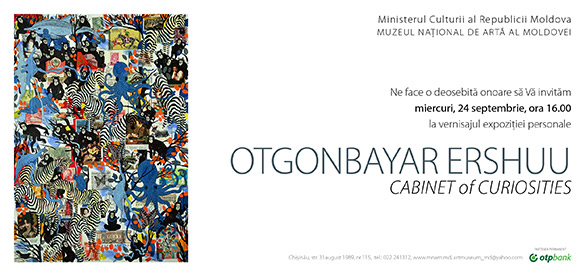
Otgonbayar Ershuu was born in 1981 in Ulaanbaatar, Mongolia. His talent was discovered early, and at the age of 15 he organized his first solo exhibitions. He studied traditional Mongolian painting in Ulaanbaatar (1996–1998).
After graduation, he participated as a painter and restorer in several study visits to historical sites in Mongolia. He studied various techniques in Buddhist-Lamaist temples, the iconography of miniature painting, as well as their spiritual foundations.
Between 2007 and 2010 he studied at the Berlin University of the Arts, graduating with a Master of Arts degree. After his studies, OtGO opened the first Mongolian Cultural Center in Berlin (2010–2013) and founded ZURAG Gallery Berlin (2010–2014)—the first gallery founded and directed by a Mongolian outside Mongolia.
In 2015, OtGO was awarded the Grand Prize at the International Painting Biennale in Chișinău, Republic of Moldova. In 2019, he took part in the Curating Project at the Berlin University of the Arts and obtained a university certificate. Between 2018 and 2025, he worked as chief curator and head of external relations at the National Gallery of Art of Mongolia, in parallel with his artistic activity.
OtGO has exhibited his works in Japan, Sweden, France, the Netherlands, India, the Czech Republic, Switzerland, Moldova, Poland, Romania, Russia, the United Arab Emirates, Singapore, Georgia, Germany, and Mongolia.
His works can be found in various museums, institutions, and private collections, including: the National Gallery of Art of Mongolia, the Ulaanbaatar Museum (Mongolia); the National Museum of Art of Moldova, Chișinău (Republic of Moldova); the Museum of Art of Mongolia, Ulaanbaatar (Mongolia); HSBC (Hongkong & Shanghai Banking Corporation); Seeheim Castle, Constance (Germany); Old Baruth Castle (Germany); Fondation Kunstdepot, Göschenen (Switzerland); the Embassy of Mongolia in Germany; MRK Gruppe, Dresden–Munich (Germany).
The artist lives between Berlin and Ulaanbaatar.
Wednesday, September 24, 2025, at 4:00 PM,
The
National Museum of Art of Moldova invites you to the opening of the
exhibition of the artist Otgonbayar Ershuu entitled “CABINET of
CURIOSITIES.”
We look forward to welcoming you to discover a unique visual universe, full of mystery and surprises!
OtGO Otgonbayar Ershuu
We look forward to welcoming you to discover a unique visual universe, full of mystery and surprises!
OtGO Otgonbayar Ershuu
Breathing in …
breathing out … in … out – drawing a line. Repeat.
This is the meditative artistic practice of Otgonbayar Ershuu, who goes by the short name, OtGO. He is one of Mongolia´s most remarkable artists and has been living in Berlin for about twenty years. A fact that has expanded his cultural experiences and also impacted on the material basis of his artistic work. His spiritual core, however, remains firmly routed in Mongolia´s cultural heritage.
Drawing line after line, after line, OtGO´s works form to become complex textures of pictorial traces, interwoven with layers of meaning. His work is meditative and iterative in many ways. Being a studied Thangkha-painter, he comes from a long tradition of religious image making in Lama-Buddhism, a tradition in which painting and meditation never were separate activities. In this tradition each line, each patch of color is both, premeditated and meditation in itself. Lamaist monks were only allowed to apply their craft to to Thangkha-painting after long years of rigorous training.
IIt is important understand that Thangkhas don´t just `represent´ the notion of a cosmic order in Buddhism, they actually manifest this order. A fact that is reflected in the process of making a Thangkha. Its composition and order were never to be discerned by the painter, instead the underlying design has always been based on long traditions and metaphysical deliberations within the faith. Someone chosen to `execute´ these concepts, had to be a person, worthy and capable of realizing an “artwork” that could manifest this superior order. Furthermore, in the process of painting a Thangka, the `painter´ who serves as a mediary to the goal of successfully channeling these spiritual energies, could only finish a Thangkha by himself to a certain point. Once almost completed, more monks would be gathering around the painter to chant and recite religious texts, while the last part was finished – the painting the eyes of all the figures, giving them their souls. Only then a Thangkha was considered to manifest the actuality of the spiritual order of the world. What does that mean? – As much as in mysticism, having the capability of sight does not mean actually `seeing´ in a deeper sense, a Thangkha transcends its material existence as a painting to become a manifestation of a higher reality.
Also noteworthy is the fact, that the Mongolian language only has one word for both, painting and drawing – zurag. While drafting (drawing) and execution (painting) in a Western tradition are very separate things, in the Mongolian tradition there is no distinction between intention/conception and realization. What that means, is that artists from Mongolia start from a very different background than our Western ideas about art.
Such is the tradition from which OtGO has departed. And departure here also means not only OtGO´s dis-, or re-location to Berlin, but also the fact that he is radically re-interpreting image-making from within his Mongolian heritage, not by shedding its spiritual dimension, but its artistic and social context. The practice of drawing line after line in a meditative state remains active in his process, the subject matter, however, now incorporates his new social and political contexts and his very personal attitudes towards them.
Take for example his massive work Cabinet of curiosities which in itself is divided into four parts, that deal with matters of life (Fetus) and death (Memento Mori) and much in between, not the least being (Horses), which for any Mongolian is a big deal, because “Mongols believe that the goal of life is to live `tegsh´, in balance with the world. One stands alone and in power at the center of the world, with the infinite blue Father Heaven (Tenger) above and Mother Earth (Gazar Eje) supporting and nurturing below. By living an upright and respectful life, a human being (hun) will keep his world in balance and maximize his personal power (windhorse, hiimori).” 1 A horse in Mongolian culture therefore is much more than a commodity, or a matter of pride, a horse is a manifestation of man´s soul, his fate and future.
The Cabinet of curiosities is comprised of hundreds of (mostly) A5-sized papers that form large blocks which serve as visual containers of OtGO´s subject matter. The first layer of those papers is formed by collages of used historic postal stamps from both Germanies, Europe, Mongolia and beyond. Those collages serve as background for OtGO´s drawings/paintings. It is important to mention here that Chinggis Khaan and his successors created the most efficient postal system the world had ever seen in the early 13th century, making it possible to relay information from the Chinese sea to the borders of Europe within 7-10 days by horse messengers. Obviously OtGO´s choice here is not just arbitrary, but a subtle allusion to the achievements of Mongolian heritage.
On top of this metaphorical `background´layer, OtGO has inscribed, not without sometimes acerbic criticism, his vision of a cosmic dis-order. His pictorial world is inhabited by men and women (both mostly naked), aquatic creatures, like the “OtGO-pus”, but also a variety of fishes and abundant jellyfish. Monkeys and zebras also play a prominent role – why? – neither of which live in Mongolia.
Asked about monkeys, his dry riposte was: “There are plenty of `monkeys´ in Mongolia.” And about zebras: “Those are beautiful, elegant animals. They look like horses, but man has never been able to domesticate them. They, in fact, are the only mammals that cannot be domesticated.” Again, this begs for an explanation and a contextualization. The first and easy answer is about the monkeys – many Mongolians suffer from the state of their nation. Even with all good intentions there are two major factions pitted against one another, and those are the proponents of traditional nomadic cultures and the post-soviet-capitalist entrepreneurs who seek to exploit Mongolia´s natural resources. Both are on a collision course about access to land. In other words, the deeply routed Mongolian ethics about living in harmony with nature is profoundly under siege from the pressures of modern economic dynamics and Western lifestyles.
The ”zebra”, as a metaphorical animal in OtGO´s work, native to Africa, a whole different continent altogether, becomes a “signature animal” in his work for the incommensurable quality of nature – an animal that cannot be subjected to man´s will. In a way this is OtGO´s way of advocating the traditional rights of nature versus man´s illicit infraction on nature´s integrity. One must know, that in Mongolian culture, just digging a hole into the soil is an impermissible violation of nomadic ethics, that at least requires a ritual, asking for permission. At the same time, exploiting natural resources is seemingly a necessity in order to develop and modernize the country. Mongolia is rich in gold, uranium, copper and coal – much of which it sells to China, a country that it shares a long mutual history with. During the Yuan dynasty (1271 – 1368), China was ruled by Mongolia. In fact, Beijing was a Mongolian foundation. The tides have turned…
Talking about tides – how does the aquatic life in OtGO´s work relate to a country that has no connection to the sea. The answer is yet another metaphor. One can think of the ocean as a vast and mostly undiscovered part of our planet. A place different to ours. In the artist´s vision this realm is also under siege by humanity – he thinks of jellyfish as a marker for pollution of the waters. However, there is also a brighter notion. The Mongolian word for ocean is далай – as in Dalai Lama. And this ocean is inhabited by many a OtGO-pus.
So, looking deeper into the artist´s work, layer upon layer starts to unfold, revealing a complex cultural heritage that he connects to with an international sensibility for the needs to protect nature, but also to assert himself as an independent artist.
There is a gap between the understanding of nature between East and West, however, that is mostly due to a hyperbolic conviction in the West about ecology, that does not have enough knowledge, nor the understanding of traditional values pertaining to nature in Mongolia, nor the sensitivity towards the cultural ramifications thereof. The West´s notion of nature is mostly (and sadly) aesthetic. Western people have forgotten how to live with nature. They are plainly romantic about it, and they still believe they can control and govern nature´s course. A notion that originates from Western monotheistic hubris. The bible has called upon its subjects to subjugate nature… – None of that exists in Asian cultures.
Nature in Mongolia is never separate from human life until today. Proof of that is in the fact that shamanic practice is still strong and widely practiced. At the core of those practices is the need for all Mongolians to find a balance between “Tenger” and “Gazar Eje”2. This tradition in Mongolia is older and stronger than that of Lama-Buddhism. Most Mongolians would identify with Tengrism before they would with other denominations. However, already during Möngkhe Khaan´s reign (grandson of Chinggis Khaan) almost all international religions were present at his court in Kharkhorin – originally just for reasons of gathering intelligence. A fact that makes Mongolia a very liberal society in terms of religion today.
This heritage has enabled OtGO to fluidly connect to Western cultures and incorporate pictorial traditions into his work. There is a discernable adaptability in Mongolia that vouches for its future. Surprisingly, most Mongolians call Germany their third neighbor. Being wedged between China and Russia, about one percent of Mongolians actually speak German ( which in a population of about three million people means 30 000 individuals), a fact which owes a lot to strong ties between the formerly communist part of Germany and Mongolia. Whatever this may mean – there are tangled histories and wild aspirations to deal with. And it is even more complex. Mongolia and Tibet share an almost 500 years long tradition of Lama-Buddhism. The first and most important artist in that context was Zanabazar, who was trained as a Buddhist monk in Tibet and returned to Mongolia in the second half of the 17th century to become the spiritual leader of Mongolia, a powerful diplomat and the finest of artists – some even call him the Michelangelo of Mongolia. His influence is strong until today, inspiring contemporary artists to work in the tradition of a Lamaist pictorial heritage.
However, in the long history of the country, much of its identity was repressed – during the Chinese Manchu occupation, or the Soviet empire. Whenever in modern times Mongolia found a way to assert its own identity and traditions, Lama iconography came up again as an integrating force. It has since simply been called: Mongol Zurag – Mongol painting. A practice, that was not allowed during the Manchu occupation, nor during Soviet times. After 1990 however, is became a strong force again.
In essence, art in Mongolia today is fueled by its cultural heritage rooted in Tengrism first, Lama-Buddhism second, and the achievements of what Pope Francis, when visiting Mongolia, called the “Pax Mongolica”, a period of 250 years of peace after the revolutions of Chinggis Khaan.
The work of OtGO is not only witness to these energies. His work is channeling notions of art from and in Mongolia. OtGO is not just part of it – he is a driving force in this dynamic.
Thomas Eller
This is the meditative artistic practice of Otgonbayar Ershuu, who goes by the short name, OtGO. He is one of Mongolia´s most remarkable artists and has been living in Berlin for about twenty years. A fact that has expanded his cultural experiences and also impacted on the material basis of his artistic work. His spiritual core, however, remains firmly routed in Mongolia´s cultural heritage.
Drawing line after line, after line, OtGO´s works form to become complex textures of pictorial traces, interwoven with layers of meaning. His work is meditative and iterative in many ways. Being a studied Thangkha-painter, he comes from a long tradition of religious image making in Lama-Buddhism, a tradition in which painting and meditation never were separate activities. In this tradition each line, each patch of color is both, premeditated and meditation in itself. Lamaist monks were only allowed to apply their craft to to Thangkha-painting after long years of rigorous training.
IIt is important understand that Thangkhas don´t just `represent´ the notion of a cosmic order in Buddhism, they actually manifest this order. A fact that is reflected in the process of making a Thangkha. Its composition and order were never to be discerned by the painter, instead the underlying design has always been based on long traditions and metaphysical deliberations within the faith. Someone chosen to `execute´ these concepts, had to be a person, worthy and capable of realizing an “artwork” that could manifest this superior order. Furthermore, in the process of painting a Thangka, the `painter´ who serves as a mediary to the goal of successfully channeling these spiritual energies, could only finish a Thangkha by himself to a certain point. Once almost completed, more monks would be gathering around the painter to chant and recite religious texts, while the last part was finished – the painting the eyes of all the figures, giving them their souls. Only then a Thangkha was considered to manifest the actuality of the spiritual order of the world. What does that mean? – As much as in mysticism, having the capability of sight does not mean actually `seeing´ in a deeper sense, a Thangkha transcends its material existence as a painting to become a manifestation of a higher reality.
Also noteworthy is the fact, that the Mongolian language only has one word for both, painting and drawing – zurag. While drafting (drawing) and execution (painting) in a Western tradition are very separate things, in the Mongolian tradition there is no distinction between intention/conception and realization. What that means, is that artists from Mongolia start from a very different background than our Western ideas about art.
Such is the tradition from which OtGO has departed. And departure here also means not only OtGO´s dis-, or re-location to Berlin, but also the fact that he is radically re-interpreting image-making from within his Mongolian heritage, not by shedding its spiritual dimension, but its artistic and social context. The practice of drawing line after line in a meditative state remains active in his process, the subject matter, however, now incorporates his new social and political contexts and his very personal attitudes towards them.
Take for example his massive work Cabinet of curiosities which in itself is divided into four parts, that deal with matters of life (Fetus) and death (Memento Mori) and much in between, not the least being (Horses), which for any Mongolian is a big deal, because “Mongols believe that the goal of life is to live `tegsh´, in balance with the world. One stands alone and in power at the center of the world, with the infinite blue Father Heaven (Tenger) above and Mother Earth (Gazar Eje) supporting and nurturing below. By living an upright and respectful life, a human being (hun) will keep his world in balance and maximize his personal power (windhorse, hiimori).” 1 A horse in Mongolian culture therefore is much more than a commodity, or a matter of pride, a horse is a manifestation of man´s soul, his fate and future.
The Cabinet of curiosities is comprised of hundreds of (mostly) A5-sized papers that form large blocks which serve as visual containers of OtGO´s subject matter. The first layer of those papers is formed by collages of used historic postal stamps from both Germanies, Europe, Mongolia and beyond. Those collages serve as background for OtGO´s drawings/paintings. It is important to mention here that Chinggis Khaan and his successors created the most efficient postal system the world had ever seen in the early 13th century, making it possible to relay information from the Chinese sea to the borders of Europe within 7-10 days by horse messengers. Obviously OtGO´s choice here is not just arbitrary, but a subtle allusion to the achievements of Mongolian heritage.
On top of this metaphorical `background´layer, OtGO has inscribed, not without sometimes acerbic criticism, his vision of a cosmic dis-order. His pictorial world is inhabited by men and women (both mostly naked), aquatic creatures, like the “OtGO-pus”, but also a variety of fishes and abundant jellyfish. Monkeys and zebras also play a prominent role – why? – neither of which live in Mongolia.
Asked about monkeys, his dry riposte was: “There are plenty of `monkeys´ in Mongolia.” And about zebras: “Those are beautiful, elegant animals. They look like horses, but man has never been able to domesticate them. They, in fact, are the only mammals that cannot be domesticated.” Again, this begs for an explanation and a contextualization. The first and easy answer is about the monkeys – many Mongolians suffer from the state of their nation. Even with all good intentions there are two major factions pitted against one another, and those are the proponents of traditional nomadic cultures and the post-soviet-capitalist entrepreneurs who seek to exploit Mongolia´s natural resources. Both are on a collision course about access to land. In other words, the deeply routed Mongolian ethics about living in harmony with nature is profoundly under siege from the pressures of modern economic dynamics and Western lifestyles.
The ”zebra”, as a metaphorical animal in OtGO´s work, native to Africa, a whole different continent altogether, becomes a “signature animal” in his work for the incommensurable quality of nature – an animal that cannot be subjected to man´s will. In a way this is OtGO´s way of advocating the traditional rights of nature versus man´s illicit infraction on nature´s integrity. One must know, that in Mongolian culture, just digging a hole into the soil is an impermissible violation of nomadic ethics, that at least requires a ritual, asking for permission. At the same time, exploiting natural resources is seemingly a necessity in order to develop and modernize the country. Mongolia is rich in gold, uranium, copper and coal – much of which it sells to China, a country that it shares a long mutual history with. During the Yuan dynasty (1271 – 1368), China was ruled by Mongolia. In fact, Beijing was a Mongolian foundation. The tides have turned…
Talking about tides – how does the aquatic life in OtGO´s work relate to a country that has no connection to the sea. The answer is yet another metaphor. One can think of the ocean as a vast and mostly undiscovered part of our planet. A place different to ours. In the artist´s vision this realm is also under siege by humanity – he thinks of jellyfish as a marker for pollution of the waters. However, there is also a brighter notion. The Mongolian word for ocean is далай – as in Dalai Lama. And this ocean is inhabited by many a OtGO-pus.
So, looking deeper into the artist´s work, layer upon layer starts to unfold, revealing a complex cultural heritage that he connects to with an international sensibility for the needs to protect nature, but also to assert himself as an independent artist.
There is a gap between the understanding of nature between East and West, however, that is mostly due to a hyperbolic conviction in the West about ecology, that does not have enough knowledge, nor the understanding of traditional values pertaining to nature in Mongolia, nor the sensitivity towards the cultural ramifications thereof. The West´s notion of nature is mostly (and sadly) aesthetic. Western people have forgotten how to live with nature. They are plainly romantic about it, and they still believe they can control and govern nature´s course. A notion that originates from Western monotheistic hubris. The bible has called upon its subjects to subjugate nature… – None of that exists in Asian cultures.
Nature in Mongolia is never separate from human life until today. Proof of that is in the fact that shamanic practice is still strong and widely practiced. At the core of those practices is the need for all Mongolians to find a balance between “Tenger” and “Gazar Eje”2. This tradition in Mongolia is older and stronger than that of Lama-Buddhism. Most Mongolians would identify with Tengrism before they would with other denominations. However, already during Möngkhe Khaan´s reign (grandson of Chinggis Khaan) almost all international religions were present at his court in Kharkhorin – originally just for reasons of gathering intelligence. A fact that makes Mongolia a very liberal society in terms of religion today.
This heritage has enabled OtGO to fluidly connect to Western cultures and incorporate pictorial traditions into his work. There is a discernable adaptability in Mongolia that vouches for its future. Surprisingly, most Mongolians call Germany their third neighbor. Being wedged between China and Russia, about one percent of Mongolians actually speak German ( which in a population of about three million people means 30 000 individuals), a fact which owes a lot to strong ties between the formerly communist part of Germany and Mongolia. Whatever this may mean – there are tangled histories and wild aspirations to deal with. And it is even more complex. Mongolia and Tibet share an almost 500 years long tradition of Lama-Buddhism. The first and most important artist in that context was Zanabazar, who was trained as a Buddhist monk in Tibet and returned to Mongolia in the second half of the 17th century to become the spiritual leader of Mongolia, a powerful diplomat and the finest of artists – some even call him the Michelangelo of Mongolia. His influence is strong until today, inspiring contemporary artists to work in the tradition of a Lamaist pictorial heritage.
However, in the long history of the country, much of its identity was repressed – during the Chinese Manchu occupation, or the Soviet empire. Whenever in modern times Mongolia found a way to assert its own identity and traditions, Lama iconography came up again as an integrating force. It has since simply been called: Mongol Zurag – Mongol painting. A practice, that was not allowed during the Manchu occupation, nor during Soviet times. After 1990 however, is became a strong force again.
In essence, art in Mongolia today is fueled by its cultural heritage rooted in Tengrism first, Lama-Buddhism second, and the achievements of what Pope Francis, when visiting Mongolia, called the “Pax Mongolica”, a period of 250 years of peace after the revolutions of Chinggis Khaan.
The work of OtGO is not only witness to these energies. His work is channeling notions of art from and in Mongolia. OtGO is not just part of it – he is a driving force in this dynamic.
Thomas Eller
1 A Course in Mongolian
Shamanism – Introduction 101, Golomt Center for Shamanist Studies
(Hg.), Ulaanbaatar, Mongolia 1997, https://members.tripod.com/Mongolian_Page/shaman.txt
2 Tenger being the abstract deity of the sky (heaven would be a misleading term) and Gazar Eje (representing the female aspect of the earth)
2 Tenger being the abstract deity of the sky (heaven would be a misleading term) and Gazar Eje (representing the female aspect of the earth)

Otgonbayar Ershuu was born in 1981 in Ulaanbaatar, Mongolia. His talent was discovered early, and at the age of 15 he organized his first solo exhibitions. He studied traditional Mongolian painting in Ulaanbaatar (1996–1998).
After graduation, he participated as a painter and restorer in several study visits to historical sites in Mongolia. He studied various techniques in Buddhist-Lamaist temples, the iconography of miniature painting, as well as their spiritual foundations.
Between 2007 and 2010 he studied at the Berlin University of the Arts, graduating with a Master of Arts degree. After his studies, OtGO opened the first Mongolian Cultural Center in Berlin (2010–2013) and founded ZURAG Gallery Berlin (2010–2014)—the first gallery founded and directed by a Mongolian outside Mongolia.
In 2015, OtGO was awarded the Grand Prize at the International Painting Biennale in Chișinău, Republic of Moldova. In 2019, he took part in the Curating Project at the Berlin University of the Arts and obtained a university certificate. Between 2018 and 2025, he worked as chief curator and head of external relations at the National Gallery of Art of Mongolia, in parallel with his artistic activity.
OtGO has exhibited his works in Japan, Sweden, France, the Netherlands, India, the Czech Republic, Switzerland, Moldova, Poland, Romania, Russia, the United Arab Emirates, Singapore, Georgia, Germany, and Mongolia.
His works can be found in various museums, institutions, and private collections, including: the National Gallery of Art of Mongolia, the Ulaanbaatar Museum (Mongolia); the National Museum of Art of Moldova, Chișinău (Republic of Moldova); the Museum of Art of Mongolia, Ulaanbaatar (Mongolia); HSBC (Hongkong & Shanghai Banking Corporation); Seeheim Castle, Constance (Germany); Old Baruth Castle (Germany); Fondation Kunstdepot, Göschenen (Switzerland); the Embassy of Mongolia in Germany; MRK Gruppe, Dresden–Munich (Germany).
The artist lives between Berlin and Ulaanbaatar.
 Vladimir Vornic, State Secretary in the Ministry of Culture of the Republic of Moldova,
Vladimir Vornic, State Secretary in the Ministry of Culture of the Republic of Moldova,Tudor Zbârnea, Director General of the Museum, Ana Eremia and OtGO
NATIONAL ART MUSEUM OF MOLDOVA OtGO Solo Show ‚Cabinet of Curiosities‘

NATIONAL ART MUSEUM OF MOLDOVA OtGO Solo Show ‚Cabinet of Curiosities‘
Diana Cernolev: Expoziția personală Cabinet of Curiosities semnată de OtGO (Moldovan and English)
Octombrie, 2025 – Chișinău, Moldova

NATIONAL ART MUSEUM OF MOLDOVA OtGO Solo Show ‚Cabinet of Curiosities‘
«Wunderkammer Göschenen» Reise
Urner Wochenblatt | 149. Jahrgang | Samstag, 28. September 2025

Prof. Simion Zamsa, OtGO and Tudor Zbârnea
NATIONAL ART MUSEUM OF MOLDOVA OtGO Solo Show ‚Cabinet of Curiosities‘

NATIONAL ART MUSEUM OF MOLDOVA OtGO Solo Show ‚Cabinet of Curiosities‘
Past exhibition:
CABINET of CURIOSITIES
VALLETTA CONTEMPORARY
16th May 2025 – 14th August 2025
A solo exhibition by OtGO
